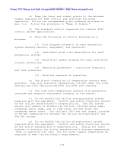
LOOP CONTROL DEVICE DEVICE ADDITIONAL
FUNCTION NUMBER FUNCTION SETPOINT RANGE PARAMETERS
SUPPLY AIR DA-XX01, DAMPER -- 4-20 ma --
TEMPERATURE 02, 03 ACTUATOR
AMU-XX01 AIR MONI- -- -- MIN. O.A.
TORING UNIT XXXX CFM
-- OUTDOOR AIR 65 F -- SOFTWARE
O
DB HI LIMIT POINT
TS-XX01 MIXED AIR 55 F 30-130 F --
O o
LOW LIMIT
TEMPERATURE
SENSOR
VLV-XX01 PREHEAT COIL -- 4-20 ma CV-10
VALVE CLOSE
AGAINST
16 PSIG
TS-XX02 SUPPLY AIR 55 F 40-140 F --
O o
FAN DISCHARGE
TEMPERATURE
SENSOR
VLV-XX02 COOLING COIL -- 4-20 ma CV-20
VALVE CLOSE
AGAINST
20 PSIG
SUPPLY DUCT PS-XX01 SUPPLY DUCT 1.5 IN. 0-5 IN. --
STATIC STATIC W.G. W.G.
PRESSURE PRESSURE
SENSOR
PS-XX02 FAN DISCHARGE 3.5 IN. 0-5 IN. --
HIGH LIMIT W.G. W.G.
STATIC
PRESSURE
SENSOR
SFC-XX01 SUPPLY FAN -- 4-20 ma
VARIABLE SPEED
CONTROLLER
SAFETY & TSL-XX01 LOW 35 F -- --
o
MAINTENANCE TEMPERATURE
PROTECTION
THERMOSTAT
MIL-HDBK-1003/3
Table 17
Equipment for VAV HVAC Control System XX
123
Simpo PDF Merge and Split Unregistered Version - http://www.simpopdf.com

LOOP CONTROL DEVICE DEVICE ADDITIONAL
FUNCTION NUMBER FUNCTION SETPOINT RANGE PARAMETERS
SAFETY & SD-XX01 SUPPLY AIR -- -- --
MAINTENANCE SMOKE DETECTOR
(CONT’D) SD-XX02 RETURN AIR -- -- --
SMOKE DETECTOR
DP-XX01 FILTER STATUS 0.5 IN. 0-2 IN. --
DIFFERENTIAL W.G. W.G.
PRESSURE
TS-XX04 RETURN AIR -- 50-100 F --
O
TEMPERATURE
SENSOR
SUPPLY FAN R-XX01 SUPPLY FAN -- -- --
START RELAY
CS-XX01 SUPPLY FAN -- -- --
CURRENT SENSOR
ROOM SENSORS TS-XX04 ROOM H-70 F 50-100 F WITH
O o
(MULTIPLE) TEMPERATURE C-76 F SETPOINT
o
SENSORS N-55 F ADJUST-
o
MENT &
OVERRIDE
SWITCH
DA-XX04 VAV TERMINAL -- 4-20 ma ONE PER
BOX COLD AIR ZONE
VALVE
VLV-XX03 VAV HEATING -- 4-20 ma CV VARIES
COIL VALVE CLOSE
AGAINST
16 PSIG
R-XX02 VAV TERMINAL -- -- --
BOX FAN START
RELAY
MIL-HDBK-1003/3
Table 17 (Continued)
Equipment for VAV HVAC Control System XX
h) Room Control Mode: A room type dry bulb
temperature sensor located in the most critical spot shall, on a
rise in dry bulb temperature in the space, gradually open the VAV
terminal box cold air valve.
8.6 Commissioning Procedures
8.6.1 Functional Performance Test. Participate in the
functional performance test as described in ASHRAE Guideline 1.
124
Simpo PDF Merge and Split Unregistered Version - http://www.simpopdf.com

MIL-HDBK-1003/3
Verify and document the performance of the control system as
required by the Commissioning Plan prepared by the Commissioning
Authority. Final positions of manual balancing dampers and
valves shall be marked on the device. Permanently record, on
system equipment schedule, the final setting of controller
proportional, integral, and derivative constant settings in units
and terminology specific to the controller. This will become
part of the O&M manual.
8.6.2 Preparation for Acceptance Testing. Execute a detailed
static and functional checkout procedure to ensure that systems
are ready for functional performance testing.
8.6.3 System Static Checkout
8.6.3.1 Observation. Provide a detailed inspection to assure
that all equipment is properly mounted, sensors are properly
installed and connected, control devices are properly installed,
and controllers and control devices are properly connected.
8.6.3.2 Calibration. Check, verify, and calibrate all sensors
including those sensors that are "factory calibrated." Perform a
two-point accuracy check of the calibration of each HVAC control
system sensing element by comparing the HVAC controller readout
to the actual value of the variable measured at the sensing
element or airflow measurement station location. Use digital
indicating test instruments, such as digital thermometers,
motor-driven psychrometers, and tachometers. Test instruments
shall be at least twice as accurate as the specified sensing
element-to-controller readout accuracy. Calibration of test
instruments shall be traceable to National Institute of Standards
and Technology (NIST) standards. In the shutdown condition,
calibration checks shall verify that the sensing element-to-
controller readout accuracies at two points are within the
specified product accuracy tolerances. If not, re-calibrate or
replace the inaccurate device and repeat the calibration check.
a) Check insertion temperature and immersion
temperature sensing element and transmitter-to-controller readout
calibration accuracy at one physical location along the axis of
the sensing element.
b) Check averaging temperature sensing element and
transmitter-to-controller readout calibration accuracy every 2
feet along the axis of the sensing element in the proximity of
the sensing element, for a maximum of 10 readings. Then average
these readings.
125
Simpo PDF Merge and Split Unregistered Version - http://www.simpopdf.com

MIL-HDBK-1003/3
c) Verify space type sensors by placing the test
instrument as close as possible to the sensor to measure
identical conditions. Maintain the test for a sufficient length
to ensure achieving stable conditions.
8.6.3.3 Operation
a) Each controller shall be configured for its
specified service. Verify each sequence of operation for each
HVAC system and subsystem. Verify that each controlled device
responds to the proper controller, in the proper manner, and at
the proper time. Verify the fail-safe position for each
component of the system.
b) Set the time schedule of controllers in accordance
with the sequence of operation and the established time schedule.
8.6.4 System Dynamic Checkout. Perform weather-dependent
test procedures that cannot be performed by simulation in the
appropriate climatic season. When simulation is used, verify the
actual results in the appropriate season.
a) Use the controllers' manual-automatic switches as
the means of manipulating control devices such as dampers and
valves to check operation and to effect stable conditions, prior
to making measurement checks.
b) Perform a controller tuning procedure, which shall
consist of setting the initial proportional, integral, and
derivative (PID) mode constants, controller setpoints, and
logging the settings. Tuning shall be self-tuning operation by
the controller unless manual tuning is necessary.
8.6.4.1 Controller Manual-Tuning Procedure. A controller
manual tuning procedure is described in three steps using a
constant temperature setpoint controller as an example.
a) Step 1. This step shall consist of the following:
(1) Index the controller manual-automatic switch
to the automatic position, and set the integral and derivative
mode constants to zero.
(2) Set the proportional mode constant to an
initial setting of 8 percent. This corresponds to a 2.0 ma per
degree F or a 1.5 psig per degree F proportional controller
output change for a 100-degree F span. This causes the
controller output signal to vary from zero output to full output
for an input signal change representing an 8-degree F change.
126
Simpo PDF Merge and Split Unregistered Version - http://www.simpopdf.com

MIL-HDBK-1003/3
(3) Controllers for other variables, such as
relative humidity and static pressure, shall have their
proportional mode constants set initially in a similar manner for
an achievable output range proportional to the transmitter span.
b) Step 2. This step shall consist of the following:
(1) Set the controller temperature setpoint at any
achievable temperature. Observe the controller output and
transmitter input.
(2) If the transmitter input continuously
oscillates above and below the setpoint without settling at a
fixed value, or if such oscillation increases, the proportional
mode constant is too small.
(3) If the proportional mode constant is too
small, increase it in steps until the transmitter input indicates
stable control at any temperature, if the controller output is
not at either extreme of the output range.
(4) If the temperature control point slowly drifts
toward or away from the controller setpoint, the proportional
mode constant is too large. Decrease its setting in steps until
oscillations occur as described in the preceding paragraphs, and
then increase the setting until stable control occurs.
(5) Introduce a step change in controller
setpoint. This should cause the controller to overshoot the
setpoint slightly, with each subsequent overshoot peak value
decreasing by a factor of two-thirds until stable control is
achieved at, above, or below the setpoint.
(6) Increase the integral mode constant setting in
small steps, and introduce setpoint changes until control point
and controller setpoint coincide at stable control. This should
happen consistently after a setpoint change within a short time,
such as 5 to 10 minutes.
c) Step 3. This step shall consist of the following:
(1) Unless the HVAC process variable changes
rapidly, the derivative mode constant setting can remain at zero.
This is usually the case for most HVAC applications.
(2) If derivative control is needed, gradually
increase the derivative mode constant.
127
Simpo PDF Merge and Split Unregistered Version - http://www.simpopdf.com

![Hệ thống HVAC và Dehumidifying: Tổng quan [Năm hiện tại]](https://cdn.tailieu.vn/images/document/thumbnail/2012/20120202/luly_meo1/135x160/hvac_and_dehumidifiying_systems_b_split_14_8134.jpg)
![Hệ thống HVAC và Dehumidifying: Tổng quan [Năm hiện tại]](https://cdn.tailieu.vn/images/document/thumbnail/2012/20120202/luly_meo1/135x160/hvac_and_dehumidifiying_systems_b_split_13_3651.jpg)
![Hệ thống HVAC và Dehumidifying: [Thêm từ mô tả/định tính để tăng CTR]](https://cdn.tailieu.vn/images/document/thumbnail/2012/20120202/luly_meo1/135x160/hvac_and_dehumidifiying_systems_b_split_12_8041.jpg)
![Hệ thống HVAC và Dehumidifying: [Thông tin chi tiết/Hướng dẫn/Lựa chọn]](https://cdn.tailieu.vn/images/document/thumbnail/2012/20120202/luly_meo1/135x160/hvac_and_dehumidifiying_systems_b_split_11_4149.jpg)
![Hệ thống HVAC và hệ thống hút ẩm: [Thông tin chi tiết/Hướng dẫn/Lựa chọn tốt nhất]](https://cdn.tailieu.vn/images/document/thumbnail/2012/20120202/luly_meo1/135x160/hvac_and_dehumidifiying_systems_b_split_10_7992.jpg)

![HVAC và Dehumidifying Systems: Hệ thống điều hòa không khí và hút ẩm [chuẩn SEO]](https://cdn.tailieu.vn/images/document/thumbnail/2012/20120202/luly_meo1/135x160/hvac_and_dehumidifiying_systems_b_split_7_2859.jpg)
![HVAC và Dehumidifying Systems: [Mô tả chi tiết/Hướng dẫn/Đánh giá]](https://cdn.tailieu.vn/images/document/thumbnail/2012/20120202/luly_meo1/135x160/hvac_and_dehumidifiying_systems_b_split_6_8164.jpg)
![Hệ thống HVAC và Dehumidifying: [Thông tin chi tiết/Hướng dẫn/Lựa chọn]](https://cdn.tailieu.vn/images/document/thumbnail/2012/20120202/luly_meo1/135x160/hvac_and_dehumidifiying_systems_b_split_5_3816.jpg)
![HVAC và Dehumidifying Systems: [Thêm thông tin chi tiết để tối ưu SEO]](https://cdn.tailieu.vn/images/document/thumbnail/2012/20120202/luly_meo1/135x160/hvac_and_dehumidifiying_systems_b_split_4_7836.jpg)








![Ngân hàng trắc nghiệm Kỹ thuật lạnh ứng dụng: Đề cương [chuẩn nhất]](https://cdn.tailieu.vn/images/document/thumbnail/2025/20251007/kimphuong1001/135x160/25391759827353.jpg)






